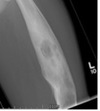Osteomyelitis Flashcards
What is osteomyelitis?
Inflammatory condition of bone caused by INFECTION, usually involving a single bone.
What is the aetiology of osteomyelitis? (x3) Infants? Children? Adults? Elderly? IVDU?
Haematogenous spread, direct inoculation into bone, or from contiguous spread. Commonly implicated organisms: Staph. aureus, Enterobacteriaceae and anaerobic bacteria. There are additional pathogens seen in certain population groups: Infants: Group B Strep. and Candida. Children: Group A Strep. Adults: coagulase-negative. Staph. Older adults: Gram negative bacilli. IVDU: Pseudomonas aeruginosa.
What are the risk factors for osteomyelitis? (x8)
Penetrating injury, IVDU, diabetes, HIV, surgery, sickle cell disease, RA, CKD.
What is the pathophysiology of haematogenous osteomyelitis?
Osteomyelitis is caused by biofilm-forming bacteria which adhere to bone and produce polysaccharide ECM, forming a BIOFILM. Once a sufficient number of organisms are present in the biofilm, cell-to-cell signalling permits seeding of infection into the bone leading to osteomyelitis. Infection leads to bone necrosis, reactive new bone and surrounding inflammation of soft tissue. Occurs usually in ONE bone.
How does the pattern of infection differ between haematogenous and contiguous osteomyelitis?
- Haematogenous: affects medullary and endosteal bone (deeper regions). Usually involves metaphysis (area where epiphysis joins diaphysis (joint and long bone shaft)) of long bones in children, or the vertebral bodies in adults.
- Contiguous: superficial
What is the epidemiology of osteomyelitis?
Incidence higher in men and higher in elderly population (from diabetes-related disease).
!! What are the two types of osteomyelitis? Typical presentation of each?
- ACUTE: most commonly in unwell child with a limp or in an immunocompromised patient
- CHRONIC: most commonly in adults with a history of open fracture, previous orthopaedic surgery, or a discharging sinus
What are the signs and symptoms of chronic osteomyelitis? (x3)
- Non-specific pain at site of infection, tenderness on percussion
- Low-grade fever
- Erythema, local inflammation and swelling
What are the signs and symptoms of acute osteomyelitis? (x4)
- Limp or reluctance to bear weight with areas of point tenderness (unlike non-specific pain and tenderness only on percussion in chronic)
- Fever over 38 degrees
- Erythema, local inflammation and swelling
- Limb deformity, such as angular deformity or limb shortening, in children
What are the signs of symptoms of native vertebral osteomyelitis? (x3) Associations? (x3)
- Associated with IVDU, lower extremity and hip infections, and TB
- Lower back pain localised to the infected disc space, worsened on physical activity, may radiate to abdomen, hip, leg or groin.
- Spinal cord/nerve root compression and meningitis may occur
- Limitation of movement
What are the investigations for osteomyelitis? (x5)
- PLAIN X-RAYS
- FBC: WCC, ESR and CRP may be raised in acute, normal in chronic
- BLOOD CULTURE: aetiology and determine treatment
- IR BONE BIOPSY: may indicate infective organism or show other pathology. This is the ideal form of diagnosis, though not always realistic in practice
- CT/MRI not for diagnosis, but to visualise extent of bone destruction
What may plain x-ray show in osteomyelitis? (x3)
- ACUTE: osteopenia after week of disease onset, evidence of bone destruction, periosteal reaction
- CHRONIC: intermedullary (resorption of inner layer of cortex), cavities and ‘fallen leaf’ sign when a piece of endosteal sequestrum has detached and fallen into the medullary canal (shown in image)
- VERTEBRAL: thinning of affected vertebral body and then anterior bone destruction



